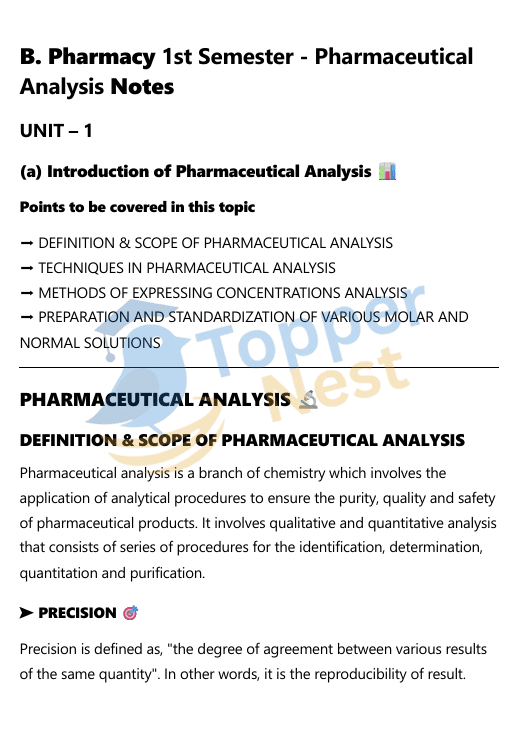Pharmaceutical analysis is a foundational subject in the B. Pharmacy. It deals with the identification, quantification and purification of chemical substances, ensuring the safety, efficacy and quality of drugs and pharmaceuticals. This unit covers the core concepts such as analytical techniques, standards, preparation of standard solutions, handling of errors and regulatory aspects like pharmacopoeias and impurity testing. If you want more notes related B. Pharmacy: TopperNest.

What is Pharmaceutical Analysis?
Pharmaceutical analysis is a scientific discipline that applies various analytical procedures and techniques to study the chemical composition, structure, and behavior of pharmaceutical substances and products. It is a critical branch of chemistry within the pharmaceutical industry.
Pharmaceutical analysis utilizes a wide array of techniques, including:
Spectroscopy: UV-Vis, IR, NMR, Mass Spectrometry (MS), Atomic Absorption (AA), Fluorescence spectroscopy. These techniques measure the interaction of electromagnetic radiation with matter to identify and quantify substances.
Chromatography: High-Performance Liquid Chromatography (HPLC), Gas Chromatography (GC), Thin-Layer Chromatography (TLC), Liquid Chromatography-Mass Spectrometry (LC-MS), Gas Chromatography-Mass Spectrometry (GC-MS). These methods separate components of a mixture for individual identification and quantification.
Errors in Pharmaceutical Analysis
Errors are an inherent part of any analytical process, and pharmaceutical analysis is no exception. Given the critical nature of drug quality, safety, and efficacy, minimizing and understanding these errors is paramount. Errors in pharmaceutical analysis can lead to incorrect results, which could have severe consequences, from patient harm to regulatory non-compliance and significant financial losses for pharmaceutical companies.
Errors are generally classified into two main types:
- Determinate (Systematic) Errors: These errors have a definite value, an identifiable cause, and are often consistent and reproducible. In principle, they can be discovered, measured, and corrected. They lead to a bias in the results, meaning measurements are consistently too high or too low.
- Indeterminate (Random) Errors: These errors are unpredictable, fluctuate randomly, and cannot be assigned to a specific identifiable cause. They arise from uncontrolled variables that are always present in any measurement, reflecting the inherent limitations of instruments and human ability to make precise measurements. They affect the precision of the measurements, causing results to scatter around a mean value.
Pharmacopoeia
A pharmacopoeia is an official, legally binding publication that contains a collection of standards and quality specifications for medicinal substances, excipients (inactive ingredients), and dosage forms. These books are published by a national government or an authorized medical/pharmaceutical society and are given legal authority within a specified jurisdiction.
Key characteristics and purpose of a Pharmacopoeia:
- Standards of Quality: It sets precise standards for the identity, purity, strength (assay), and quality of pharmaceutical ingredients and finished products.
- Legal Authority: Compliance with pharmacopoeial standards is often mandatory for the manufacture, import, export, and sale of pharmaceutical products within that country or region.
- Monographs: The core of a pharmacopoeia consists of individual entries called “monographs.” Each monograph provides detailed information for a specific drug substance or product, including:
- Chemical name and structure
- Description (physical appearance)
- Identification tests (to confirm identity)
- Assay (to determine the amount of active ingredient)
- General Chapters: Besides monographs, pharmacopoeias include general chapters that describe analytical methods, reagents, and apparatus, as well as general requirements for dosage forms and pharmaceutical preparations.
- Harmonization: Major pharmacopoeias (e.g., United States Pharmacopeia (USP), European Pharmacopoeia (EP), Japanese Pharmacopoeia (JP), Indian Pharmacopoeia (IP), British Pharmacopoeia (BP)) collaborate to harmonize standards globally, facilitating international trade and ensuring consistent quality of medicines worldwide.
- Patient Safety: By establishing stringent quality control parameters, pharmacopoeias play a vital role in safeguarding public health by ensuring that patients receive safe, effective, and high-quality medicines.
Frequently Asked Questions (FAQs)
1. What is the difference between primary and secondary standards?
- Primary standards are pure and stable and can be used directly.
- Secondary standards need to be standardized using a primary standard.
2. Why is standardization of solutions important?
Standardization ensures accurate concentration, which is critical for precise analytical results.
3. What are limit tests used for?
Limit tests check for the presence of harmful impurities in pharmaceutical substances, ensuring drug safety.
4. How do systematic and random errors differ?
Systematic errors are consistent and correctable, while random errors are unpredictable and occur by chance.
5. What are some commonly used pharmacopoeias in pharmacy?
- IP (Indian Pharmacopoeia)
- USP (United States Pharmacopoeia)
- BP (British Pharmacopoeia)
